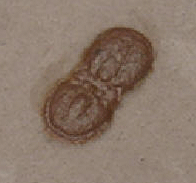|
The Order AGNOSTIDA (Salter,
1864) The representatives of the Agnostida are usually only a few mm in size. As aforementioned the representatives of the order Agnostida probably have led a planctonic way of life. One biotic indices concerning this mode of life is the wide global distribution of a big number of fossil Agnostides within a very short- time geological period. In the majority this trilobites come upon enrolled. A typical characteristic of this order is the nearly identical construction in size and outline of cephalon and pygidium (isopygous), as well as the low number of thoracic segments. The AGNOSTIDA are including the suborders Agnostina and Eodiscina.
A representative of the suborder Agnostina is shown at the right image. |
 Ptychagnostus cuyanus |
|
Epoch Lower Cambrian until the end of Upper Ordovician. As readily identifiable on the representative of the Ptychagnostidae, the cephalon is outlined parabolic, whereupon the maximum width is located anterior of the genal angle. With the exception of some representatives of the Eodiscina, the Agnostides were eyeless. The sutures (if present) are ending anterior to the genal angle at cephalons border (proparian), The glabella is, except for the representatives of the family Condylopygoidea, conical outlined. The natant hypostome indicates a particle feeder.
The representatives of Suborder Agnostina solely featuring 2 thoracic segments (e. g. Ptychagnostus cuyanus) whereas some representatives are fractionally featured with 3 thorcic segments.
The tails shield is isopygous (Gr.- rump) i. e. it's regarding to size, shape and construction nearly identical to trilobites cephalon.
|
|